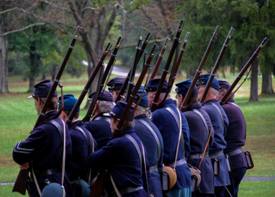
Built by the colony of Maryland in 1756, Fort Frederick played an important role in the early development of Western Maryland. Unusually substantial for the time, its walls were built of stone and the interior included three large, spacious buildings. The fort aided in defending the frontier of Maryland during the French and Indian War. As the threat of Indian raids subsided, the fort was abandoned in 1759. During the American War of Independence, the fort was converted into a prisoner of war camp, where hundreds of British prisoners were housed. No longer needed for military purposes, the state of Maryland sold the fort and about 100 acres of land at public auction in the 1790s.
Throughout the first half of the 19th Century, the fort and surrounding grounds were used for agricultural purposes, and changed ownership several times. In 1860, Nathan Williams, whose family would maintain ownership for the next 51 years, purchased the property. By this time the barracks had disappeared due to time as well as scavengers looking for a ready supply of lumber and nails.
With the outbreak of the Civil War in 1861, the area around Fort Frederick once again became important militarily. The Chesapeake and Ohio Canal, which passes one-quarter mile south of the fort (the railroad did not yet exist on this side of the river), and the Baltimore and Ohio Railroad on the opposite (then Virginia) side of the river, became focal points of defense for the Union Army. In December, the 1st Maryland Infantry (U.S.), under the command of Colonel John Kenly, was assigned to protect the canal and guard the fords and ferries of the Potomac River between Four Locks, to the east, and Cherry Run, to the west. Company H of this regiment was ordered to occupy Fort Frederick. On Christmas Day, 1861, these troops fought a skirmish with Confederate Cavalry. The skirmish took place along the Potomac River below the fort and the Union troops guarding the river were successful in defending the canal, but were not able to prevent Confederates from tearing up the railroad on the other side. On January 1, 1862, another skirmish took place at the fort, as Union Troops again repulsed confederates attempting to tear up the railroad.
Fort Frederick continued to be occupied, and in January 1862, with the 1st Maryland being redistributed to guard points further west towards Hancock, Company D replaced Company H here. These troops remained until the end of February, when they, along with others, crossed the Potomac to guard the reconstruction of the B&O Railroad. Also during this period of time, Union artillery was placed at the fort and was used against the Confederates in Virginia.
This is the last occurrence of the fort’s use by a military command. However, the area around the fort remained vulnerable to Confederate Raiders through the rest of the war. Hence, troops frequently passed near the fort and at times occupied grounds now encompassed by the state park. Most notable was October 1862 when a picket of the 12th Illinois Cavalry was assigned to the canal "immediately south of old Fort Frederick."
The Williams Family and Fort Frederick
Nathan Williams was the son of Samuel “Big Sam” Williams, a slave who in 1826 bought freedom for himself, his wife, and four children. In 1839, Sam purchased a farm near Four Locks, about 3 1/2 miles east of Fort Frederick along the Potomac River. While there, Nathan fell in love with a slave named Ammy from an adjoining farm. Nathan bought her freedom in 1846 for $60. On the eve of the Civil War in 1860, Nathan and Ammy bought the Fort Frederick property for $7,000.
While the 1st Maryland Infantry garrisoned the fort during the early months of the war, officers occupied several rooms in the Williams’ home, which was located near the present park gift shop. Ammy cooked meals for them. Nathan was able to increase his fortunes by selling produce to Union soldiers on the Maryland side of the river, as well as Confederates on the Virginia (now West Virginia) side. He justified his fraternization with the rebels by supplying information to the federal troops.
Following the war, Nathan dismantled most of the northwest bastion of the fort in order to construct a barn. Inside the fort, he added fences to pen animals, and planted grape vines, produce, and a small orchard. The fields outside the fort were also tilled and cultivated. As a testimony to his success, Nathan acquired more property and expanded his agrarian ventures.
In 1884, Nathan Williams died, and the farm passed to his family. By the 1890s, public sentiment in Maryland spurred efforts by the state to reacquire the fort. The Williams property, including the fort and 189.5 acres, was sold in 1911, having been owned by the family for 51 years. The state acquired the property in 1922, making Fort Frederick Maryland's first state park.